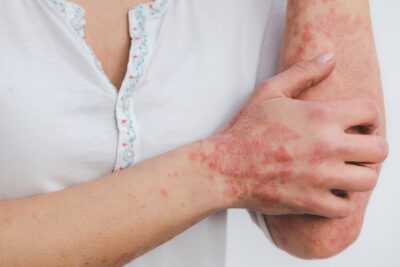November 5, 2024
Many people are concerned about stretch marks, which appear as long, narrow streaks or lines on the skin and can vary in colour from red or purple to white or silver. Though they are not harmful, they can make people feel self-conscious. Stretch marks often develop on the abdomen, thighs, hips, breasts, and upper arms. They are commonly associated with rapid changes in weight, pregnancy, and growth spurts during puberty.
This article will explore different methods to avoid getting stretch marks. We’ll cover various strategies, from establishing an effective skincare routine to maintaining a nutritious diet and knowing when to seek professional advice. With a little effort and consistency, you can keep your skin healthy and reduce the chances of stretch marks forming. Let’s dive into the tips and tricks that can help keep your skin smooth and even-toned.
Understanding What Stretch Marks Are
Stretch marks, or striae, are long, narrow streaks or lines that develop on the skin. They often appear on body parts that store fat, such as the abdomen, thighs, hips, breasts, and upper arms. Stretch marks form when the skin stretches or contracts quickly, causing the collagen and elastin fibres to break. As the skin heals, it forms these distinctive marks.
Several factors contribute to the development of stretch marks. Rapid weight gain or loss is a common cause. When weight changes quickly, the skin doesn’t have enough time to adjust, leading to tears in the supportive tissue. Pregnancy is another frequent cause due to the rapid expansion of the abdomen. Hormonal changes during puberty can also trigger stretch marks.
Genetics play a role, too. If your parents had stretch marks, you might also be more likely to get them. Understanding these causes can help you take steps to prevent stretch marks from forming. Keeping the skin moisturized and maintaining a stable weight are vital factors.
Effective Skincare Routine to Prevent Stretch Marks
To prevent stretch marks, a good skincare routine is essential. Keeping your skin hydrated and healthy can make it more elastic and less prone to tearing. Here are some steps to include in your daily routine:
Moisturize Regularly:
– Applying a good moisturizer can help keep your skin supple and hydrated. Look for creams or lotions rich in ingredients like cocoa butter, shea butter, and vitamin E. These ingredients nourish the skin, making it more resilient.
Stay Hydrated:
– Drinking enough water is crucial for maintaining skin elasticity. Aim for at least eight glasses of water a day. Proper hydration helps your skin stay soft and reduces the risk of developing stretch marks.
Exfoliate:
– Regular exfoliation can remove dead skin cells and promote the growth of new, healthy skin. Use a gentle scrub or a loofah to exfoliate areas prone to stretch marks, such as your stomach, thighs, and hips.
Use Oils:
– Applying oils like almond oil, coconut oil, and olive oil can also help. These oils penetrate deep into the skin layers and improve elasticity. Massage the oil into your skin in circular motions to enhance blood flow and absorption.
Wear Sunscreen:
– Sun damage can weaken the skin and make it more susceptible to stretch marks. Always apply sunscreen to areas that will be exposed to the sun. Choose a broad-spectrum sunscreen with SPF 30 or higher.
Following these steps can strengthen your skin and reduce the chances of developing stretch marks. Consistency is critical, so make these practices a part of your routine to maintain healthy skin.
Nutritional Tips for Healthy Skin
What we eat plays a significant role in the health of our skin. Including certain nutrients in your diet can make your skin more resilient and reduce the chances of getting stretch marks.
Vitamin C:
– Vitamin C is vital for collagen production, which keeps the skin firm and elastic. Eat oranges, strawberries, bell peppers, and broccoli to get enough vitamin C.
Zinc:
– Zinc helps with skin repair and healing. Foods like nuts, seeds, and whole grains are good sources of zinc. Including zinc-rich foods in your diet can support skin health and prevent stretch marks.
Protein:
– Proteins are the building blocks of skin tissue. Eating enough protein helps the skin repair itself and stay strong. Include chicken, eggs, beans, and tofu in your meals.
Vitamin E:
– Vitamin E is an antioxidant that protects the skin from damage. Nuts, seeds, and green leafy vegetables are good sources of vitamin E. Eating these can help keep your skin healthy and elastic.
Healthy Fats:
– Omega-3 fatty acids in fish, flaxseeds, and walnuts support skin health. These fats keep the skin moisturized and improve elasticity. Including them in your diet can keep stretch marks at bay.
When to Seek Professional Help
While many home remedies and preventive steps can help, some stretch marks may require professional attention. Knowing when to seek help can make a big difference in your results.
Severe Stretch Marks:
– If your stretch marks are severe and cover large areas of your body, it might be time to consult a dermatologist. They can assess your skin and recommend effective treatments.
Persistent Stretch Marks:
– Stretch marks that remain even after trying various home remedies or over-the-counter treatments may need professional care. Laser therapy, microdermabrasion, and chemical peels can be more effective.
Discomfort:
– Seeing a dermatologist is a good idea if your stretch marks are itchy or painful. They can provide treatments to ease discomfort and improve the appearance of your skin.
Preventive Advice:
– Consulting a dermatologist during pregnancy, puberty, or weight changes can help. They can offer personalized advice and treatments to prevent stretch marks before they start.
Professional Treatments:
– Dermatologists have access to advanced treatments like laser therapy and chemical peels. These treatments can reduce the appearance of stretch marks and improve skin texture.
Conclusion
Stretch marks can be a concern, but you can take steps to prevent them and keep your skin healthy. Understanding what causes stretch marks and following a good skincare routine can improve your skin’s resilience. Adding nutrient-rich foods to your diet will further support skin health and elasticity. Don’t hesitate to seek professional help when home remedies aren’t enough.
At VIDA Dermatology, we understand the importance of healthy skin. Our dermatologist in Edmonton is ready to provide personalized treatments for stretch marks. Book a consultation with VIDA Dermatology today and discover the best ways to keep your skin smooth and vibrant. Your journey to better skin starts with a simple step. Let’s achieve healthy, beautiful skin together.



